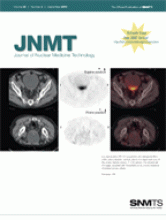Twice a year at the mid-winter and annual meetings, I report to the publications committees of both the SNM and the SNMTS about the state of the Journal of Nuclear Medicine Technology. Although most of my presentation concerns statistics on the number of submissions and the time to publication, there is also a discussion of overall concerns and trends.

Jan M. Winn, MEd, RT(N), CNMT Executive Director, JRCNMT
An ongoing concern is the lack of technologist reviewers (although this number has increased significantly during my term) and the unwillingness of reviewers to take on a manuscript. Some members of the SNMTS publications committee believed that many technologists were uncertain as to what would be expected of them in reviewing submissions.
A few years ago, the JNMT published an article entitled “A Systematic Guide to Reviewing a Manuscript” (2006;34:92–99), which is a good description of this process. Over the past several years, I have made copies and mailed this article to many technologists who had questions about reviewing.
However, I think the main question the publications committee posed was what I look for in a review, and that is what I hope to address here. A good review is like a good manuscript; it is really easy to recognize. But what constitutes an acceptable review may be a bit more subjective.
Initially, what I look for in a reviewer is someone who has specific areas of expertise. Except for submissions on general clinical issues, I will ignore those in the reviewer pool who list themselves as experts in everything, and I will look instead for individuals who list 3–6 main areas of interest or expertise. Sometimes, I have limited my searches to technologists only, and that is why we added the expertise/interest category of CNMT.
When I first became editor, one reviewer turned in a review so good that I thought this would be the norm and my job would be so easy. This reviewer continues to do amazingly fine reviews that stand out every time. I am going to paraphrase some of her comments for a demonstration of the process.
Besides providing numeric scores on the originality, methodology, presentation, and priority of each article, reviewers must state their possible conflicts of interest, comment on the length of the article, determine whether they find the data correct and whether the research raises any ethical issues, and finally, recommend whether to accept the submission. In addition, reviewers make specific comments to the editor and to the author.
For a submission this year concerning biodistribution of a peptide, this particular reviewer recommended that the article should be accepted with minor revision, believed that the article was timely and of use to the scientific and medical community, and found that the authors had addressed most of the problems in their discussions but had some inconsistencies in their methods. For the authors, there were 7 bulleted topics of concern covering errors in tables, the need to reduce the methods section and not overstate the results, confusion in specific sentences and parts of the discussion, and some minor editorial issues. Both the editor and the author had clear guidelines for proceeding.
For a submission in 2007 on the biokinetics of targeted receptors, this reviewer recommended rejection primarily because the statistical methods were inappropriate and the results were not significant. For the author, there were 10 comments and suggestions on the section covering function and expression of the peptide, the inappropriateness of some references, the length of the methods section, the statistical differences, and the conclusions.
Although these manuscripts were on somewhat complex topics, the reviews demonstrated an understanding of the process. Comments to the editor were general and indicated an overall impression, whereas comments to the author were specific and explanatory. At no time were any derogatory statements made, and all comments were designed to be helpful for both the author and the editor.
In 2009 another good reviewer, who primarily reviews clinical studies or educational papers for me, completed a review on an imaging procedure submission, recommending an acceptance with minor revisions. For the editor, the reviewer stated that the article was well done and that, although the topic was not particularly new, it was a nice demonstration of additional techniques. For the author, there were 7 recommendations, mostly covering misspellings, poor sentence structure, the need to add images, confusion in the tables, and comments about the conclusion.
I hope this overview of the review process will provide some understanding of what I hope to get from a reviewer. The review should give both the editor and the author positive input on how to proceed. I am, as usual, always available for comments and questions (fneagley{at}pacbell.net), and I hope that all technologists will consider becoming involved in the journal by submitting or reviewing articles.







